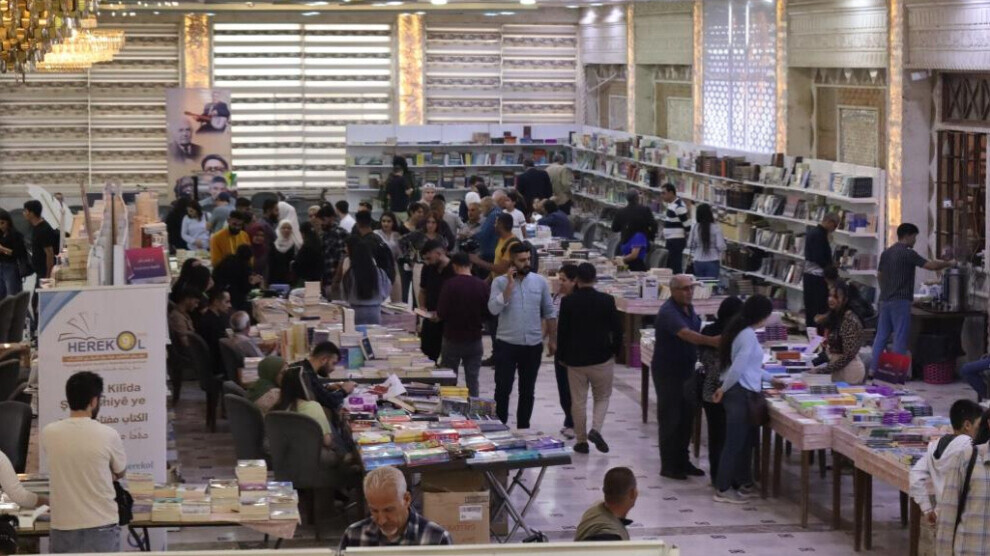“A Single Earring”: A Writer Documents the Memory of the Revolution Through Stories of Kurdish Women Fighters
During her participation in the Martyr Herkul Book Fair, writer Botan Hoshi, originally from the city of Amuda in the Jazira Canton of the Autonomous Administration of North and East Syria, unveiled her first literary work titled .

Silva Al Ibrahim
Qamishlo -The book “Fera guhar” features a collection of short stories inspired by real events, shedding light on the struggles of Kurdish women who were martyred while defending their land and dignity. Among them is Hoshi’s last encounter with her martyred friend, and another story titled “The Last Bullet” about her friend Biman, who refused to surrender to ISIS.
Like many women of her generation who lived through the revolution in North and East Syria, Botan Hoshi experienced deep pain that motivated her to turn to writing. Her name soon shone among those authors who transformed the ink of their pens into a lasting revolution on paper. Hoshi, 35 years old and from Amuda, signed her debut book “Fera guhar” for the first time at the Martyr Herkul Book Fair.
The book contains several short stories based on true accounts of individuals who struggled away from the spotlight and media attention. It also delves into themes of migration and the suffering of people during wartime. Notably, most of the protagonists in the book are women fighters from the Women’s Protection Units (YPJ) who were martyred defending their dignity and homeland against occupation.
Hoshi embarked on her Kurdish literary journey at the onset of the Rojava Revolution, reclaiming a voice that had long been suppressed under the Ba’ath regime, which banned the Kurdish language. She studied Kurdish literature and history at the Jaladat Badirkhan Academy, and as the revolution progressed, she began to document her lived experiences through stories to preserve them in memory.
“Throughout history, women were deprived of writing history and exploring its depths, as they were denied the right to express themselves and their societies. History also failed to recognize the Kurdish people's struggle for freedom. Through Kurdish literature, we were able to open new horizons to document our revolution and sacrifices, so that future generations never forget what their ancestors endured and achieved.”
She adds, “What we witnessed during the revolution were not just events - they shaped our psyche and personalities. We lived through war in all its pain, and writing became the only outlet that gave us the strength to speak.”
The Story Behind "A Single Earring"
According to Hoshi, the title “Fera guhar” (“A Single Earring”) was inspired by a real story she lived with one of her classmates at the Art Institute in Aleppo.
“After graduating, my friend - who was from Afrin - and I each returned to our hometowns. We never met again, despite several failed attempts due to the worsening security conditions that came with the Syrian war.”
She recounts that during the Turkish invasion of Afrin:
“I joined the crowds marching in solidarity with the people of Afrin. Amid the huge rally that filled the horizon, I suddenly heard someone calling my name. When I turned around, I saw my friend’s familiar face, her smile, and her braided hair. She was wearing the uniform of the Women’s Protection Units, carrying the responsibility of defending her land and people. It was not an ordinary meeting - it felt like a miracle. She hugged me warmly, and when we parted, she refused to say goodbye. I gave her one of my earrings and told her I’d be waiting for the day she’d return it to me.”
A few days later, Hoshi received the heartbreaking news that her friend had been martyred.
“I longed for a reunion that never came. Fate destined a different meeting - at her grave. But when I arrived at the cemetery, I found all the martyrs’ graves unmarked. I felt the same despair I did when I lost her among the crowds - until I noticed a woman sitting silently beside a grave, tears streaming down her face. When I approached, I saw she was wearing the same earring I had given my friend. At that moment, I knew - she was my friend’s mother, and I had finally found the resting place I’d been searching for with my heart before my eyes.”
“The Last Bullet”… Immortality Instead of Surrender
Another poignant story in the book tells of Hoshi’s friend Biman, whom she met while studying Kurdish literature at the beginning of the Rojava Revolution.
“Biman was martyred in the resistance of Kobani against ISIS. Surrounded by the enemy alongside another fighter, they refused to surrender or be captured. Instead, they chose to achieve eternal freedom through martyrdom - rather than allow their dignity to be violated.”
Writing History: A Matter of Emotion, Not Duty
Hoshi explains that no words can ever truly honor the sacrifices of the martyred women who gave their lives to protect their land and people. She emphasizes the crucial role of writers in preserving the history of revolutions and the sacrifices of those who have been historically marginalized.
“Women writers have a vital role in documenting the stories of these heroines through their words, ideas, and emotions. They can best capture such sacrifices - not because it’s an obligation, but because it’s a moral responsibility toward future generations, history, and the truth.”
Notably, women’s participation in the Martyr Herkul International Book Fair reached 40%, reflecting their growing presence in the literary field. This also underscores the leadership of Kurdish women in recording history, addressing neglected issues, and their remarkable evolution as intellectuals and writers.
